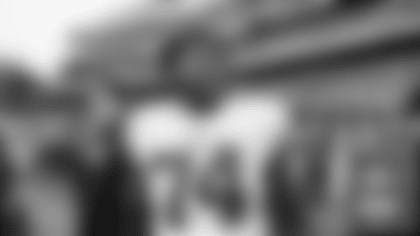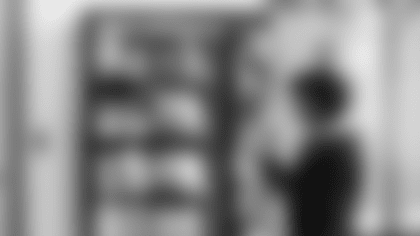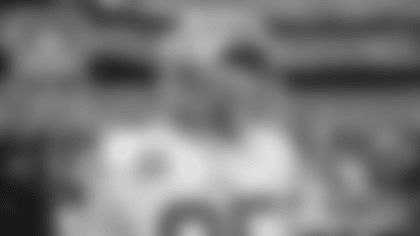Offensive coordinator Mike Martz chatted with local media following Monday's morning practice. Check out some of the highlights!
Q: People have said that in the past you haven't had a real offensive threat at tight end. This year you have two. How do you work guys like Vernon Davis and Delanie Walker into being a contributing part of this offense?A: What makes it hard on the defense is the fact that there are potential blockers. If they weren't, it has a different effect on the defense. And, if Frank Gore was not backed up, all those things with that inside receiver (he's a blocker and a runner), you would get different structures of defense where a vertical tight end can become a serious threat, which he is. Both of those guys are.
**Q: Vernon Davis caught 52 passes last year. A lot of people thought he could have been more productive. As you look back on the film, what do you see? How do you get more production out of a guy like that?

**A: Fifty-two [catches] is pretty good production. That's really good for the tight end position. What we'll do with him is try to take advantage of his speed. And then, maybe like they've done in the past, we'll try and get him down the field and, more or less like a wide receiver, move him out and move him around. At first it was so different for him, but he's really adapted very well to it.
Q: In 1975, you were at San Jose State studying biomechanics. What did you learn there from studying discus throwers, etc, to help you become a better football coach?A: When I was in that bachelor's program there, we had to take a kinesiology class and analyze movements and it really helps you to teach, for example, your quarterbacks to understand the physics of it. The balance, the lines of force, the kinetic energy, and all that kind of stuff…it really does help you focus on what's really important and help to streamline their techniques and make them most efficient. You're not just repeating what somebody taught you years ago, you're trying to teach a kinesthetic sense. It's just about leverage and balance and energy, those kinds of things, and if at any position you are balanced, you've got a chance. In that position, it's getting them balanced up in a position where they can get the ball out.
Q: Have you watched the film from the morning practice? In the 11-on-11, did Alex Smith get in sync with his balance those last seven plays after you talked to him about some of the first four 'misses'?
A: A miss may be a miss, or it may be that somebody's in the wrong spot, or there are a lot of things happening when you miss. It's not just because he missed. Maybe the receiver had the wrong route. Maybe he got bumped half way through. Maybe he misjudged and thought. There are a lot of things. He didn't miss anything. There were some missed balls, but it wasn't just a missed throw. We're still putting things in, and he was trying to bend the receiver when we wanted him straight. So, all those communication things we're trying to get ironed out in camp. He didn't miss anything. He looked sharp.
Q: What type of things will we see Frank Gore do this season that he hasn't done in previous seasons?
A: We use him everywhere we can in the running game, of course, and in the passing game we'll use him everywhere possible – as a deep threat, as a short threat, as a crossing threat. Watching him out there, he's really comfortable with himself and we've got to be careful not to overload him and take away from what he's there for and what he does really well, which is running the football. We'll create some scenarios for him.
Q: Zak Keasey, most of the time, has been Frank Gore's lead blocker. Is that because Keasey allows Gore to have a lead blocker who can get to the outside faster than, maybe, a Moran Norris can?
A: I think Zak has got a real good feel for getting through traffic and getting on linebackers and DBs as a blocker He's unusual about it. It's kind of a lost art, if you will. He sees things and reacts to things very, very well – very quickly and has such good body control that he can avoid and get into little tiny holes and jump through and get to a linebacker. It's hard to find guys that can do that, and he does that very well. Mo (Norris) is more of a real powerful, get on that line, and blow them up kind of deal. They're different kinds of fullbacks, but they're both effective."
Q: You've got two talented tight ends. How do you expect teams to match up defensively? Can teams go dime? How would the cat and mouse game go with Delanie Walker and Vernon Davis out there?
A: I don't know. You know, I really don't know because we haven't got going with that yet. I guess that would probably all work out. But the one thing that's premised on is that they're both substantial blockers. If they're not, then they'll be treated like receivers and you have more nickel and dime in there. We got to make sure that those two guys are first and foremost blockers. They understand that, and they do a good job with that. Of course defensively, you've got to create run defenses for Frank back there, as opposed to more coverage oriented things, you know what I mean? With nickel and things. So, if they're not real good blockers, then it makes it a little bit easier on the defense."
Q: Where will you be during game?
A: I'll be in the box. I think it's the best spot, the most effective spot for me with Ted (Tollner) here and the staff to deal with the quarterbacks. We've got plenty of guys on the sideline. Probably a little more comfortable up there calling plays, really. I think it's probably the best spot for me to be.
Q: You have the reputation for taking more chances than other offensive coordinators. Looking at the quarterbacks here, do you wish they would go downfield more? Go more for the intermediate route other than the dump-off pass? How do you look at these early practices? Do you say, "Come on guys, lets push it a little bit"?A: No, I'm never happy with the choices at this time in camp, especially with new quarterbacks. You got to be decisive, very decisive, and most of the time they do a very good job with that, but we're not where we need to be in terms of that. They don't have those kinds of choices to make. In other words, there's no judgment. We're not going to do what they want to do because they think they should go downfield, or go short, or check down. They have to locate, identify the defense, make a real quick decision based on what we've told them to do and stay right with that. There's no interpretation involved wih that.
Q: There's no check down?
A: Ok, here's how this works now. Our quarterbacks don't come out, and we don't give them, 'OK now, you can throw the ball deep, you can throw it intermediate or you can check it down.' They don't have those options. Here's what the play is. The ball should go here with this kind of coverage. Make the throw. It's not there, check it down, you see what I'm saying? We don't give them that kind of flexibility. We don't do that here. It's very, very, very, very structured and rigid, and that's the only way this thing works. They don't come back and play and have an option to throw it deep, middle, or check. They don't have that based on how they feel, if they want to throw it deep, or if they want to check it down. It's they have to read and see what the defense does and make that decision off of that. But it's not one, it's not a judgment of what they want to do, it's a reaction of what the defense has taken away, and that's how we do it.
Q: So there are times when they'll just throw to a spot?
A: There's times when they throw the ball and you won't see anybody in 10 yards, and all of a sudden there the guy is. Sure it works like that. Does that make sense? So when you get a lot of, 'Well, he's not going down the field as much as he should.' Well, maybe the defense said, 'We're not going to let you do that.' The ball has to go here. And that's ok too. For us, at that position, the quarterback position is a position of read and react. When we give them a play, we give them a set of things they need to do: here's your first, second, third choice. And then the read part of it is to come back in that order and cancel it out as it goes. You know what I mean? That has to be done really fast. There's no judgment. I think I can get this deep now. It's not how that goes.
Q: Do you like shotgun formation? Do you practice that?
We do have some shotgun. We're not quite there yet. That's one of the last things we deal with. That really moves towards two-minute. I'm not a real big fan of shotgun because we like to get things out real fast. We like to have the ball underneath the center with having the chance to hand it off or throw it real quick. The shotgun eliminates some of that.
Q: What about no huddle?
A: I like no huddle. I like no huddle a lot.
Q: At what point would you start working on that in camp?
A: Along with our two-minute stuff. That's what our two-minute is, no huddle. There's so much to learn and be comfortable with for these players before we get to that. Because then you're changing plays, and all that kind of stuff. There's so much to do before we get to that.
Q: Are you satisfied with how your quarterbacks are picking up the offense quickly enough with sharing these snaps?
A: Yeah, they're learning enough with the rotation that's going on there. There in with different receivers and what not. I thought it was going to be a little bit more of an issue, but it's not.
Q: You didn't have to be convinced to continue to do this?A: No. I've never done this before. I was kind of curious about it. But it's not an issue at all.





